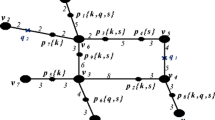Abstract
Nearest neighbor query is one of the most important operations in spatial databases and their application domains, such as location-based services and advanced traveler information systems. This paper addresses the problem of finding the in-route nearest neighbor (IRNN) for a query object tuple which consists of a given route with a destination and a current location on it. The IRNN is a facility instance via which the detour from the original route on the way to the destination is smallest. This paper addresses four alternative solution methods. Comparisons among them are presented using an experimental framework. Extensive experiments using real road map datasets are conducted to examine the behaviors of the solutions in terms of five parameters affecting the performance. The overall experiments show that our strategy to reduce the expensive path computations to minimize the response time is reasonable. The spatial distance join-based method always shows better performance with fewer path computations compared to the recursive methods. The computation costs for all methods except the precomputed zone-based method increase with increases in the road map size and the query route length but decrease with increases in the facility density. The precomputed zone-based method shows the most efficiency when there are no updates on the road map.
Similar content being viewed by others
References
A. Corral, Y. Manolopoulos, Y. Theodoridis, and M. Vassilakopoulos. “Closes pair queries in spatial databases,” Proc. ACM Conference on Management of Data (SIGMOD), 2000.
C. Jensen, J. Kolar, T. Pedersen, and I. Timko. “Nearest neighbor queries in road networks,” Proc. ACM International Symposium on Advances in Geographic Information Systems (ACM GIS), 2003.
C. Shahabi, M.R. Kolahdouzan, and M. Sharifzadeh. “A road network embedding technique for K-nearest neighbor search in moving object databases,” Proc. International Symposium on Spatial and Temporal Databases (SSTD), 2001.
D. Papadias, J. Zhang, N. Mamoulis, and Y. Tao. “Query processing in spatial network databases,” Proc. Very Large Data Bases Conference (VLDB), 2003.
GITA and OGC’s Emerging Technology Summit Series-Location-Based Services. http://www.openls.org/dvd1/ets1/index.htm.
G. Hjaltason and H. Samet. “Distance browsing in spatial databases,” Proc. ACM Transactions on Database Systems (TODS), 1999.
G. Hjaltason and H. Samet. “Incremental distance join algorithms for spatial databases,” Proc. ACM Conference on Management of Data (SIGMOD), 1998.
H. Edelsbrunner. “Alogirthms in computational geometry,” Springer-Verlag, 1987.
J.H. Rillings and R.J. Betsold. “Advanced driver information systems,” IEEE Transactions on Vehicular Technology, Vol. 40:31–40, 1991.
J.L. Wright, R. Starr, and S. Gargaro. “GENESIS-Information on the move,” Proc. of Annual IVHS American Conference, 1993.
J. Zhang, N. Mamoulis, D. Papadias, and Y. Tao. “All-nearest-neighbors queries in spatial databases,” Proc. IEEE Conf. on Scientific and Statistical Database Management (SSDBM), 2004.
J. Feng and T. Watanbe. Fast Search of Nearest Target Object in Urban District Road Networks. PYIWIT, 2002.
M.F. Worboys. GIS: A Computing Perspective. Taylor & Francis, 1995.
N. Roussopoulos, S. Kelleym, and F. Vincent. “Nearest neighbor queries,” Proc. ACM Conference on Management of Data (SIGMOD), 1995.
P. Rigaux, M. School, and A. Voisard. Spatial Databases with Application to GIS. Morgan Kaufmann, 2002.
S. Shekhar, R.R. Vatsavai, X. Ma, and J.S. Yoo. Navigation Systems: A Spatial Database Perspective. As Chapter 3 in Location Based Services, A. Voisard and J. Schiller (Eds.), Morgan Kaufmann: New York, May 2004.
S. Shekhar and S. Chawla. Spatial Databases: A Tour. Prentice Hall, 2003.
S. Shekhar, M. Coyle, and A. Kohli. Path Computation Algorithms for Advanced Traveller Information Systems. IEEE Computer Society, 1993.
S. Shekhar and J.S. Yoo. Processing In-Route Nearest Neighbor Queries: A Comparison of Alternative Approaches. ACM GIS, 2003
S. Shekhar, A. Fetterer, and B. Goyal. “Materialization trade-offs in hierarchical shortest path algorithms,” Proc. Intl. Symp. on Large Spatial Databases, 1997
S. Bespamyatnikh and J. Snoeyink. Queries with Segments in Voronoi Diagrams. SODA, 1999.
S. Hakimi, M. Labbe, and E. Schmeichel. The Voronoi Partition of a Network and its Implications Location Theory. ORSA, 1992.
S. Berchtold, B. Ertl, D. Keim, H. Kriegel, and T. Seidl. “Fast nearest neighbor search in high-dimensional space,” Proc. International Conference on Data Engineering (ICDE), 1998.
T.H. Cormen, C.E. Leiserson, R.L. Rivest, and C. Stein. Introduction to Algorithms. Second Edition. MIT Press, 2001.
W.C. Collier and R.J. Weiland. “Smart cars, smart highways,” IEEE Spectrum, 1994.
Y. Tao, D. Papdias, and Q. Shen. “Continuous nearest neighbor search,” Proc. Very Large Data Bases Conference (VLDB), 2002.
Z. Song and N. Roussopoulos. “K-nearest neighbor search for moving query point,” Proc. International Symposium on Spatial and Temporal Databases (SSTD), 2001.
Author information
Authors and Affiliations
Corresponding author
Rights and permissions
About this article
Cite this article
Yoo, J.S., Shekhar, S. In-Route Nearest Neighbor Queries. Geoinformatica 9, 117–137 (2005). https://doi.org/10.1007/s10707-005-6671-1
Received:
Revised:
Accepted:
Published:
Issue Date:
DOI: https://doi.org/10.1007/s10707-005-6671-1




